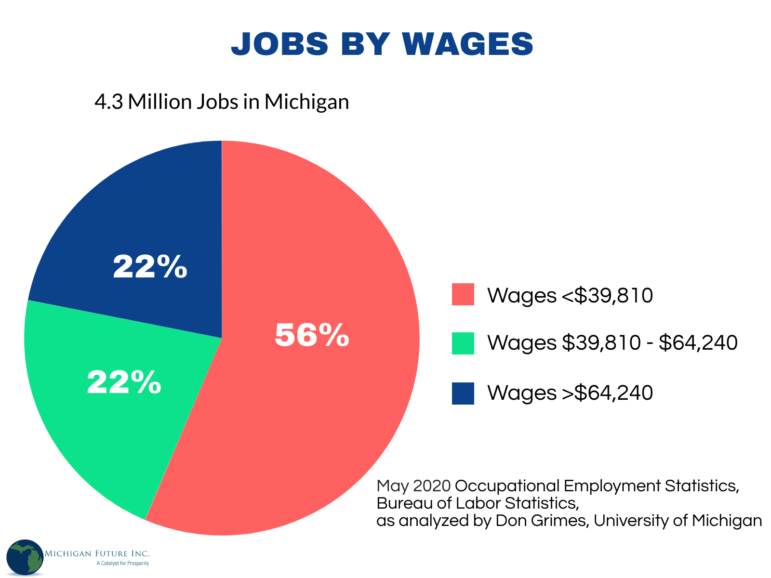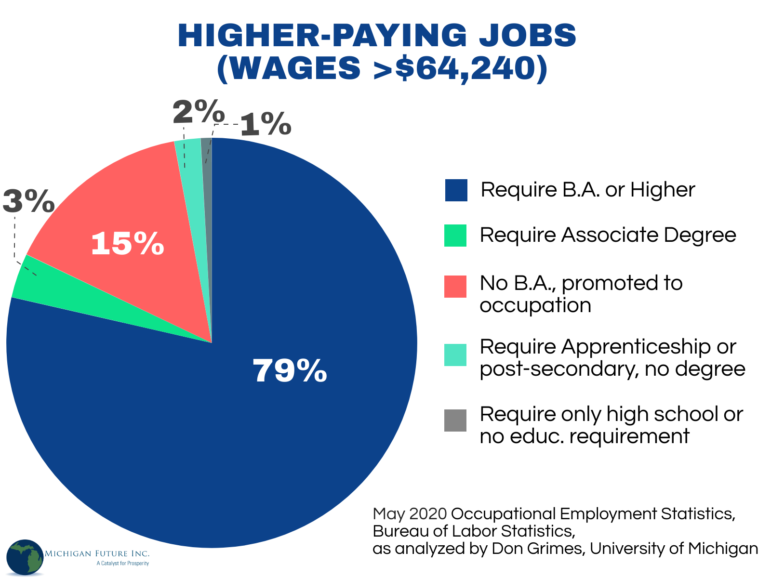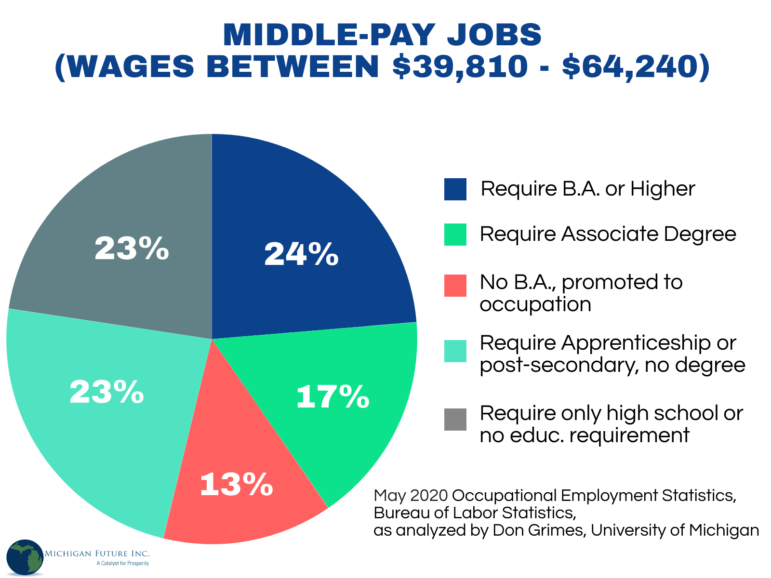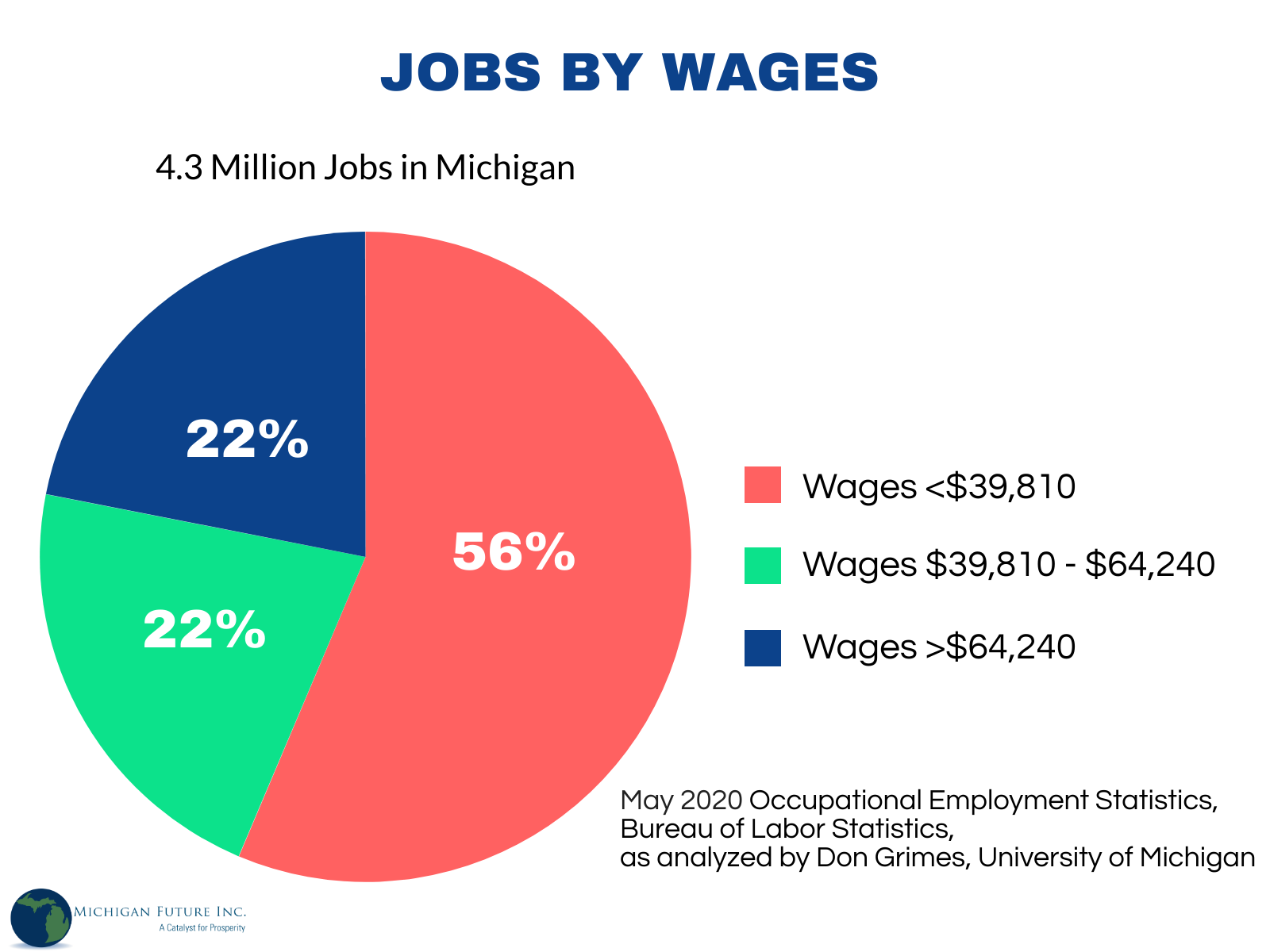We are continually confronted by the myth that there are lots of good-paying jobs that don’t require higher education. “Not everyone should go to college,” people claim. While that’s true on a personal level–not every person will benefit from college, and people find fulfillment on the job in a myriad of ways–on a community level, it’s a dangerous message. The economic data we update year-to-year show that, more and more, jobs that pay well require post-secondary education. And the best way to ensure a good-paying job is to earn a B.A. or higher.
Today we’re sharing an update to an analysis we ran in 2019, which looks at the jobs in Michigan, what those occupations pay, and what education they require. (The previous analysis used 2017 data; today’s analysis uses 2019 data).
For this analysis, we define lower-, middle-, and higher-paying jobs in relationship to the national median (half of American workers earn less, and half more) and the national 75th percentile. So, here are the headlines.
The majority of jobs in Michigan are in occupations that are lower-wage.
First, we start by looking at the 4.3 million total jobs in Michigan, and how many fall into which category. More than half–56 percent–of Michigan jobs are in lower-wage occupations. The percentages here haven’t changed much since our last analysis. If we were performing level with the national median, another 258,000 Michiganders would be in jobs in occupations that pay above the median.
This figure often surprises people. When we ask why 43 percent of Michigan households can’t afford basic necessities, this is a big part of the answer. Structurally, there are simply too many jobs that are in lower-wage occupations.

The remaining Michigan jobs are split evenly into middle-wage (between the national 50th and 75th percentiles) and high-wage occupations (top 25 percent, nationally).
Next, we look at those segments and the education levels required.
A preponderance of jobs in the higher-wage occupations require a Bachelor’s degree–or more.
Now we turn to looking at higher-wage jobs. The vast majority of these jobs are in occupations that require a four-year college degree: almost 80 percent. This is up from 77 percent when we ran this analysis on 2017 data. Even apprenticeships and associate degrees don’t land many people in the this higher-paid category (three percent of these jobs are in occupations that require apprenticeships; two percent require associate degrees).

The largest category of higher-paying occupations that don’t require a B.A. are jobs that one is promoted into–they aren’t the result of a particular educational achievement.
This one takes a bit of explaining. The category of “no B.A., promoted to occupation” that you see in the chart above (of higher-paying occupations) includes managerial roles that don’t require specific educational backgrounds. We know from other research that these jobs are not necessarily easy to come by. They tend to require job experience and really strong interpersonal skills such as collaboration and communication–the skills that make good managers.
One implication of this category’s prominence here is that it is difficult to build a strategy around, except to know that in all educational efforts, from K-12 to various post-secondary, the development of these interpersonal skills should be a goal.
The number of jobs that both pay well and require less than a B.A. is smaller than you think.
So if most of the jobs that pay higher wages require either a B.A. or are in managerial roles, what opportunities exist for those who have earned a post-secondary credential that isn’t a B.A.? As noted above, the number of jobs in middle-wage occupations is simply smaller than you might expect (especially if you still think of Michigan as a place with a broad middle class). Only 22 percent of total jobs, or around 946,000 jobs in the entire state, are in the middle-pay occupations. Within that segment, we see a wide range of educational requirements. Yet still 24 percent of those jobs require a B.A. Which means the number of jobs in middle-pay occupations that require an associate degree is 161,000. The number that require an apprenticeship or some college is around 218,000. This is not the foundation of a large, prosperous middle class that we might wish it was.

The idea that Michigan has a bunch of good-paying jobs that don’t require at least a Bachelor’s degree is a fallacy. This data are consistent with the data that show significantly higher lifetime earnings with greater education, and emerging data that people with higher education levels are weathering this pandemic more successfully (at least, by their wallets).
Data analysis by Don Grimes, University of Michigan, for Michigan Future Inc. Charts by Michigan Future. You are welcome to download and use these infographics in your own work, with proper credit.








